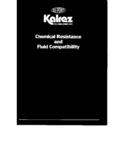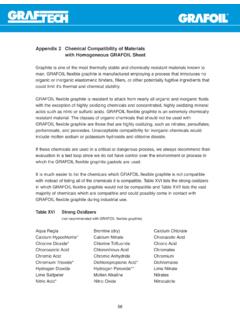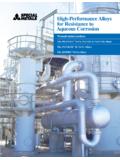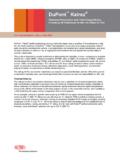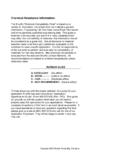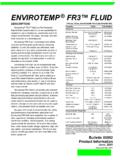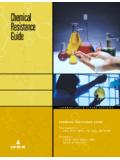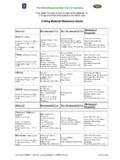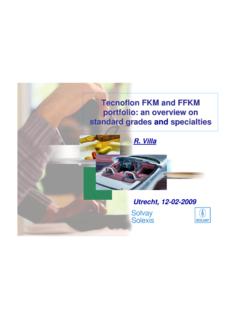Transcription of CHEMICAL RESISTANCE FLUID COMPATIBILITY
1 CHEMICAL RESISTANCEANDFLUID COMPATIBILITYKALREZ@ perfluoroelastomer parts combine the elastomeric properties of VITON fluoroelastomer with thechemical RESISTANCE of TEFLON@ fluorocarbon resins. Due to its unique properties, KALREZ perfluoroelastomerparts should be considered for service in all applications and environments where dependable long-term serviceis desired, as well as in hot and/or aggressive environments which are beyond the serviceability of guide is intended to provide assistance in determining the suitability of six commercially availableelastomers-nitrile (NBR).
2 Ethylene propylene (EPDM), silicone (SI), fluorosilicone (FSI). vinylidene fluoride basedfluoroelastomer (FKM) and KALREZ perfluoroelastomer-for service in over 1,600 chemicals and fluids. Thecriteria used for these ratings included volume swell RESISTANCE based on laboratory immersion testing, labora-tory aging tests. actual field experience and informed judgments based on experience in similar CHEMICAL ratings for the five common elastomers are based onpublished literature and are offered for general com-parative purposes only-we cannot guarantee theiraccuracy nor assume responsibility for their use.
3 The rat-ings for these five elastomers may be overly optimistic forelevated temperature and/or high concentration applica-tions since many are based on ambient temperature test-ing. Suitability of these elastomers for service at elevatedtemperatures rapidly diminishes since higher tempera-tures Increase the effects of chemicals on both the basepolymer as well as the crosslink systems. Serviceability isfurther limited by the upper service temperature limit ofeach polymer, nominally 107 C/2Z50F, 149 C/3000F,204 C/4000F, 190 C/3750F.
4 And 204Y/400 F for SI. FSI and FKM respectively-note that these limitsare based on air oxidative stability; limits for specific chem-icals are often much lower. Additronally. these elastomersare commercrally available in different grades of polymerand can vary in compound Ingredients-different gradesand compounds within a polymer class can have signifi-cantly different performance an example, consider a specific case involving an upper service temperature limit is nominally204 C/4000F. Many sources will show an A rating forFKM surtabrlity In toluene service, a common , immersion testing of commonly available FKMo-rings at a slightly elevated temperature of 50 C/1220 Ffor 168 hours shows a volume swell exceeding 24% andsignificant loss of physical properties-surely warranting a C rating.
5 Similar tests with KALREZ perfluoroelastomerparts, however, show that the A rating is maintarnedbeyond 100 RESISTANCE TABLESS ince KALREZ has outstanding CHEMICAL resis-tance, it withstands nearly all classes of chemicals-because of the combination of the highthermalsta-Wbility and excellent CHEMICAL RESISTANCE , the KALREZ perfluoroelastomer parts rating may be conser-vative,asactualfield experienceandthe example comparing the CHEMICAL and FLUID RESISTANCE ofKALREZ perfluoroelastomers to that of TEFLON fluoro-carbon resin, certain differences should be kept in mind:1)2)wKALREZ is an amorphous low modulus rubber whereasTEFLON is a crystalline high modulus plastic.
6 In fluidenvironments where high permeation occurs, KALREZ will probably swell to a greater extent than TEFLON even though the polymer is not chemically in which this is most noticeable are fullyhalogenated solvents and Serviceability ofKALREZ in these environments will be dependent uponthe specifics of the with all elastomers, it is necessary to compoundKALREZ perfluoroelastomers with fillers and curativesto gain desired mechanical properties for a limited number of environments, even though thepolymer is stable, the fillers and curative systems mayinteract with the chemicals.
7 However, since the level offillers in KALREZ perfluoroelastomers is much lowerthan in most other elastomers, such filler interactionsare generally negligible with KALREZ parts, Where suchinteractions can occur, such as in highly oxidativeenvironments, service performance is dependent on theconditions of the application and may be affected bychoice of each and every application is unique, it is recom-mended that users of KALREZ perfluoroelastomer partsalways conduct their own evaluations to determine thesuitability of KALREZ for their application.
8 Because of labo-ratory constraints and differences in field applications. theresults shown in this guide may be based on conditionswhich may not necessarily reflect actual operating environ-ments for a specific application. Additionally, many elas-tomeric materials may show excellent CHEMICAL resistanceto pure reagents in relatively short-term laboratory , they may fail in actual service because of chemicalattack by additives and/or impurities. KALREZ per-fluoroelastomer parts. with their near universal chemicalresistance, provide an extra degree of safety against theseunknown corrosive Case History booklet is available from your AuthorizedKALREZ Distributor detailing proven performance ofKALREZ parts in over 100 specific CHEMICAL on test performance in a limited number ofspecific chemicals is also available through your SYSTEMAE lastomer shows little or no effect (generallyless than 10% swell) after exposure to thechemical.
9 Slight swelling or loss of propertiesmay occur under severe conditions but thisshould not affect may be affected by the chemicalafter exposure, as evidenced by slight visibleswelling and/or loss of physical properties;in B-rated cases, KALREZ parts will oftenperform satisfactorily long after other elas-tomers have is affected by the CHEMICAL afterexposure, as evidenced by moderate to severeswelling and/or loss of physical properties;limited functionality is possible but must bedetermined by is not suitable for service in no rating is shown, insufficient informationis available to make a asterisk (*) next to a KALREZ perfluoro-elastomer rating indicates that differences may existbetween KALREZ compounds in certain applicationswhich could affect relative performance-consult yourAuthorized Distributor or Du Pont for compoundselection.
10 For such environments, other elastomersgenerally have very limited perfluoroelastomer parts, like all fluorinated prod-ucts, should not be exposed to molten or gaseous alkalimetals, such as sodium and potassium, because a highlyexothermic reaction may elevated temperatures above 100 C/2120F, servicelife may be significantly reduced in fluids containing highconcentrations of some diamines. nitric acid and basic phe-nols. KALREZ parts should always be tested for suitability. KALREZ Du Pant registered trademark for its perfluoroelastomer parts VITON.
